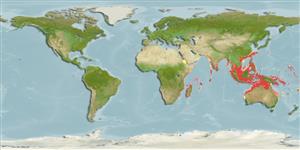分類 / Names
俗名 | 同種異名 | Catalog of Fishes(屬, 種) | ITIS | CoL | WoRMS | Cloffa
Elasmobranchii
板鰓亞綱 (鯊魚與魟魚) (sharks and rays) >
Carcharhiniformes (Ground sharks)
真鯊目 (Ground sharks) >
Hemigaleidae (Weasel sharks)
沙條鮫科 (Weasel sharks)
Etymology: Hemigaleus: hemi-, from hemisys (Gr.), half, referring to similarity to and/or close affinity with Galeus (now in Pentanchidae). (See ETYFish); microstoma: micro-, from mikros (Gr.), small; stoma (Gr.), mouth, referring to very short arched mouth compared with Chaenogaleus macrostoma, its presumed congener at the time. (See ETYFish).
More on author: Bleeker.
Issue
Specimens from Australia (and probably Papua New Guinea) are placed in Hemigaleus australiensis White, Last & Compagno, 2005 (Ref. 56150).
Environment: milieu / climate zone / depth range / distribution range
生態學
海洋 居於水底的. 熱帶; 22°C - 28°C (Ref. 244); 28°N - 30°S
Indo-West Pacific: southern India and Sri Lanka; China to Indonesia (Ref. 56150). Also from Red Sea (Ref. 93009).
Specimens found in Australia (and probably Papua New Guinea) belong to a separate species, Hemigaleus australiensis (Ref. 56150).
印度-西太平洋: 印度南部與斯里蘭卡; 中國到澳洲與阿拉弗拉海.(參考文獻 9819) 體色的差異與身體分節顯示出澳洲,而且可能地這種的印度洋北部代表可能是區分為種或亞種。 (參考文獻 13567)
Length at first maturity / 大小 / 重量 / 年齡
Maturity: Lm ?, range 78 - ? cm
Max length : 114 cm TL 雄魚/尚未辨別雌雄; (Ref. 58048)
背棘 (總數) : 0; 臀棘: 0. Australian specimens with dark-tipped fins; tooth counts 28-34/43-54; total vertebral counts 111 to 118 (Ref. 13567). Indonesian, Singapore and Thailand specimens with light-tipped fins; tooth counts 25-32/37-43; total vertebral counts 137 to 150 (Ref. 13567). Grey-brown above, lighter below, dorsal fins with white tips and posterior margins, sometimes with spots on sides of body (Ref. 13567).
用尖端深色的鰭澳洲的標本; 牙齒數 28-34/43-54; 總脊椎骨數 111 到 118.(參考文獻 13567) 印尼, 新加坡與泰國標本有淡色的-頂端了鰭; 牙齒數 25-32/37-43; 總脊椎骨數 137 到 150.(參考文獻 13567) 背面灰褐色的﹐腹面顏色較淡, 背鰭具有白色的頂端與後緣, 在身體側邊上有時有斑點.(參考文獻 13567)
A small, relatively common inshore and offshore shark of tropical continental seas (Ref. 13567). Feeds mainly on cephalopods, particularly octopi (Ref. 13567) but also takes crustaceans and cephalopods (Ref. 244). Viviparous (Ref. 50449). Taken regularly in inshore artisanal fisheries (Ref.244), commonly caught by inshore gillnet, bottom trawl and, to a lesser extent, longline fisheries. Utilized for human consumption (Ref. 244). Offal used for fishmeal (Ref. 244).
一種小的, 熱帶大陸的海洋相當普遍岸邊與外海鯊魚.(參考文獻 13567) 主要吃頭足類動物, 特別地章魚 (參考文獻 13567) 也捕食甲殼動物與頭足類動物。 (參考文獻 244) 胎生的.(參考文獻 50449) 在近海漁民中經常被捕獲並且供人類消費使用。 (參考文獻 244) 碎肉製成魚漿.(參考文獻 244)
Viviparous, with a yolk-sac placenta; 4 to 14 fetuses in a litter (Ref. 13567); 2-4 pups after a gestation period of about 6 months; born at about 45-47 cm TL (Ref. 58048). Size of full-term fetuses (detached umbilical cords and placentae) ranges from 23.7 to 25.6 cm (Ref. 244). Distinct pairing with embrace (Ref. 205).印度-西太平洋: 印度南部與斯里蘭卡; 中國到澳洲與阿拉弗拉海.(參考文獻 9819) 體色的差異與身體分節顯示出澳洲,而且可能地這種的印度洋北部代表可能是區分為種或亞種。 (參考文獻 13567)
Compagno, L.J.V., 1984. FAO Species Catalogue. Vol. 4. Sharks of the world. An annotated and illustrated catalogue of shark species known to date. Part 2 - Carcharhiniformes. FAO Fish. Synop. 125(4/2):251-655. Rome: FAO. (Ref. 244)
人類使用
漁業: 低經濟
工具
特別的報告
下載 XML
網路資源
Estimates based on models
Preferred temperature (Ref.
123201): 22.2 - 28.3, mean 27 °C (based on 816 cells).
Phylogenetic diversity index (Ref.
82804): PD
50 = 0.7539 [Uniqueness, from 0.5 = low to 2.0 = high].
Bayesian length-weight: a=0.00331 (0.00140 - 0.00781), b=3.06 (2.85 - 3.27), in cm total length, based on LWR estimates for this species & (Sub)family-body (Ref.
93245).
營養階層 (Ref.
69278): 4.2 ±0.4 se; based on diet studies.
回復力 (Ref.
120179): 非常低的, 最小族群倍增時間超過14 年 (Fec=4).
Fishing Vulnerability (Ref.
59153): High to very high vulnerability (68 of 100).
Nutrients (Ref.
124155): Calcium = 27.9 [4.5, 154.3] mg/100g; Iron = 0.693 [0.182, 2.119] mg/100g; Protein = 19 [17, 21] %; Omega3 = 0.114 [0.048, 0.271] g/100g; Selenium = 54.1 [16.0, 167.0] μg/100g; VitaminA = 22.3 [7.2, 70.4] μg/100g; Zinc = 0.769 [0.374, 1.395] mg/100g (wet weight);
